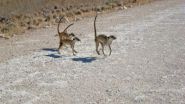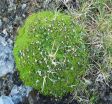(Press-News.org) In their environment, wild animals are exposed to countless threats, be they predators, diseases or natural obstacles to get over, such as gorges or rivers. In the course of evolution, they have developed specific behavioural responses to allow them to deal with these risks. In recent times, numerous man-made threats have been added to the naturally-existing ones, such as dangerous roads to cross. On the evolutionary time scale, it is excluded that the animals have evolved a whole new repertoire of adaptive responses to these risks. Simon Townsend is a behavioural biologist at the University of Zurich, and Nicolas Perony is a systems scientist at ETH Zurich. They teamed up to understand how animals cope with novel man-made threats by studying groups of wild meerkats, a species of socially-living mongooses.
The leader gives way when crossing the road
To this end, Townsend observed several meerkat groups in the Kalahari Desert. Through the reserve runs a rather heavily-frequented road, which effectively cut the animals' home range in half. On their way from one burrow to another, the meerkats are often forced to cross the road. Based on field observations, the researchers discovered that in most cases it was the highest-ranked animal — the dominant female — who led her group to the road. However, upon reaching the road she yielded to a lower-ranked individual, who took up the role of «guinea pig» to cross the road first.
Reorganisation at the front
From the observational data collected in the Kalahari, Nicolas Perony could develop a relatively simple computer model to simulate for the first time the behaviour of a meerkat group, in which there are distinct social roles. By constructing this model, the researchers were aiming to better understand what they had observed in the field. The model simulates a group of eight meerkats, one of which Perony assigned the role of leader.
In the simulations the eight agents encounter a virtual barrier, which has an effect similar to the road's. The scientists could then vary the height of the barrier — the level of the risk it represents — for each individual. The model clearly showed the reorganisation taking place at the front of the group. The ETH researcher thus concluded that the dominant female and the subordinate individuals have a markedly different appreciation of the danger presented by the road. This difference in risk perception may be enough to explain how the leading individual falls back to a less exposed position upon reaching the road, and leaves it to a subordinate individual to take the lead.
A «test individual» to minimise the risk
The dominant female's highly risk-averse behaviour appears selfish. However, it makes a lot of sense for the long-term survival of the group and the closely-related individuals in it. Meerkats in fact minimise the threat to the whole group, even though it may imply for the «test individual» to lose its life: the survival of all the group members may depend from that of the alpha individual. Observations from other researchers indeed show that the predation of the dominant female can lead to the destabilisation of the whole group.
Perony and Townsend interpret the observed behaviour at the road as the adaptation of a phylogenetically-old behavioural response, transposed to the context of a danger hitherto unknown to them. The animals can thus apply innate behavioural mechanisms to a novel, man-made threat. It is however unclear whether the meerkats really perceive the traffic on the road as a risk. A road is above all an open area in the animals' environment, in which there is no shelter to flee from predators such as eagles or jackals, says Townsend. By nature, the animals tend to avoid open areas in dangerous situations. «In case of an imminent threat, meerkats use the cover provided by bushes and other elements of their environment», explains Perony. This study raises hopes that wild animals can adapt to a certain extent to the increasing perturbation of their natural environment.
Meerkats
Meerkats have long been studied at the Kalahari Meerkat Project, located within the Kuruman River Reserve (South Africa). Animals from the study groups are dye-marked to allow for individual identification. They are habituated to the presence of human observers. Meerkats live in groups of up to 40 members. Each group is dominated by a pair of alpha individuals, who are the only ones allowed to reproduce. The other individuals help the dominant pair to care for the young, which are often related to them. The meerkats' group structure is highly complex und has long fascinated behavioural scientists.
INFORMATION:
Subordinate animals as guinea pigs
2013-02-19
ELSE PRESS RELEASES FROM THIS DATE:
Reduced sea ice disturbs balance of greenhouse gases
2013-02-19
The widespread reduction in Arctic sea ice is causing significant changes to the balance of greenhouse gases in the atmosphere. This is shown in a new study conducted by researchers from Lund University in Sweden, among others.
According to the study, the melting of sea ice in the Arctic has a tangible impact on the balance of greenhouse gases in this region, both in terms of uptake and release. The researchers have studied the greenhouse gases carbon dioxide and methane both in the tundra and in the Arctic Ocean.
"Changes in the balance of greenhouse gases can have ...
The criteria for weight-loss surgery need to be changed
2013-02-19
Weight-loss surgery is currently only offered to patients who exceed a certain BMI. However, surgical intervention could improve the health of many more people. This is shown by the Swedish Obese Subjects study carried out at the Sahlgrenska Academy, University of Gothenburg, Sweden, involving 104 patients who were operated on despite their BMI being "too low". As a result, the risk of developing diabetes was reduced by 67 percent.
In order to meet the current selection criteria for weight-loss surgery, Swedish patients must have a body mass index (BMI) above 40 for ...
Cushion plants help other plants survive
2013-02-19
Alpine cushion plants help other plants in harsh mountain environments to survive. This is shown by new research involving researchers from the University of Gothenburg, the results of which are now being publishing in the highly respected journal Ecology Letters.
Cushion plants are a type of plant found in areas such as Arctic environments, and are characterised by their distinctive, round, cushion-like shape.
A new study highlights the strong interaction between cushion plants and other plants in the most severe of mountain environments.
"Cushion plants create additional ...
New projections of 'uneven' global sea-level rise
2013-02-19
Sophisticated computer modelling has shown how sea-level rise over the coming century could affect some regions far more than others. The model shows that parts of the Pacific will see the highest rates of rise while some polar regions will actually experience falls in relative sea levels due to the ways sea, land and ice interact globally.
Reporting in the journal Geophysical Research Letters researchers have looked ahead to the year 2100 to show how ice loss will continue to add to rising sea levels. Scientists have known for some time that sea level rise around the ...
New insight into dogs fear responses to noise
2013-02-19
A study has gained new insight into domestic dogs' fear responses to noises. The behavioural response by dogs to noises can be extreme in nature, distressing for owners and a welfare issue for dogs.
The research by academics from the School of Veterinary Sciences at the University of Bristol, and funded by the RSPCA, is published in Applied Animal Behaviour Science. The study provides an important insight into dogs' fear of noises, and could improve our understanding of behavioural signs of fear or anxiety.
In the study two approaches were taken to investigate the ...
Molecules generated that can halt metastasis of colon cancer
2013-02-19
A Basque research consortium has managed to halt the progress of colon cancer and its metastasis in the liver in an experimental model with mice. This advance, that may open a new path for the future treatment of such pathologies, has been achieved by creating molecules which interfere with the adhesion of tumour cells to other cells of the organism. In this way, the molecules halt both the growth of the tumour and the dissemination of the tumour to and its proliferation in other organs.
The research, published in the prestigious North American Journal of Medicinal Chemistry, ...
CWRU study examines family struggles with anger and forgiveness when relative is dying
2013-02-19
Watching a loved one die tests some family members' relationships with God or the higher being of one's faith. And the spiritual anger and resentment grow with the level of pain and suffering their family member endures, according to researchers at Case Western Reserve University.
Psychologist Julie Exline and palliative care advanced practice nurse Maryjo Prince-Paul surveyed 147 family members with a hospice patient under home care.
More than four of every 10 respondents reported at least some level of anger with God, a major source of which was watching a loved ...
New discoveries linking gut bacteria with cholesterol metabolism give hope for the future
2013-02-19
Researchers at the Sahlgrenska Academy, University of Gothenburg, Sweden, show that cholesterol metabolism is regulated by bacteria in the small intestine. These findings may be important for the development of new drugs for cardiovascular disease.
It is well established that cholesterol is the major risk factor for cardiovascular disease. Cholesterol – which is mainly synthesized in the body but also obtained from dietary sources – is converted to bile acids in the liver, which are then secreted into the intestine and either removed from the body or recycled back to ...
When selecting a child's doctor, families prefer grapevine over online ratings
2013-02-19
ANN ARBOR, Mich. – Numerous websites are available to rate just about any service or product: restaurant food, hotel service and even a pediatrician's care. However, a new poll from the University of Michigan shows that only 25 percent of parents say they consider doctor rating websites very important in their search for a child's physician.
But the latest University of Michigan Mott Children's Hospital National Poll on Children's Health did show that younger parents, those under 30, were more likely to say that online doctor ratings are very important. And mothers were ...
National screening benchmarks for finding polyps during a colonoscopy might be too low
2013-02-19
JACKSONVILLE, Fla. — Current national guidelines provide benchmarks regarding the number of END ...

